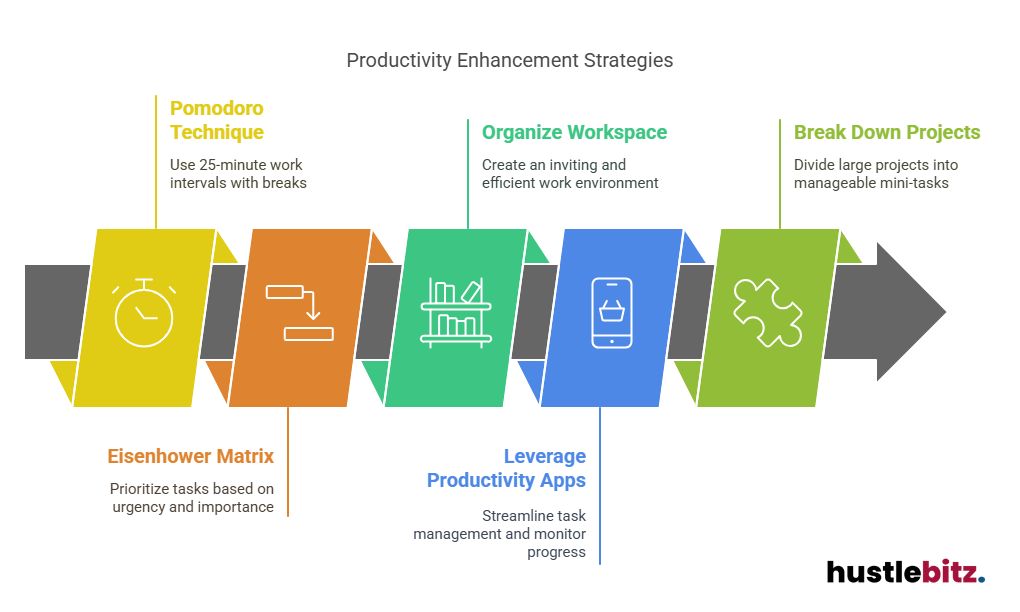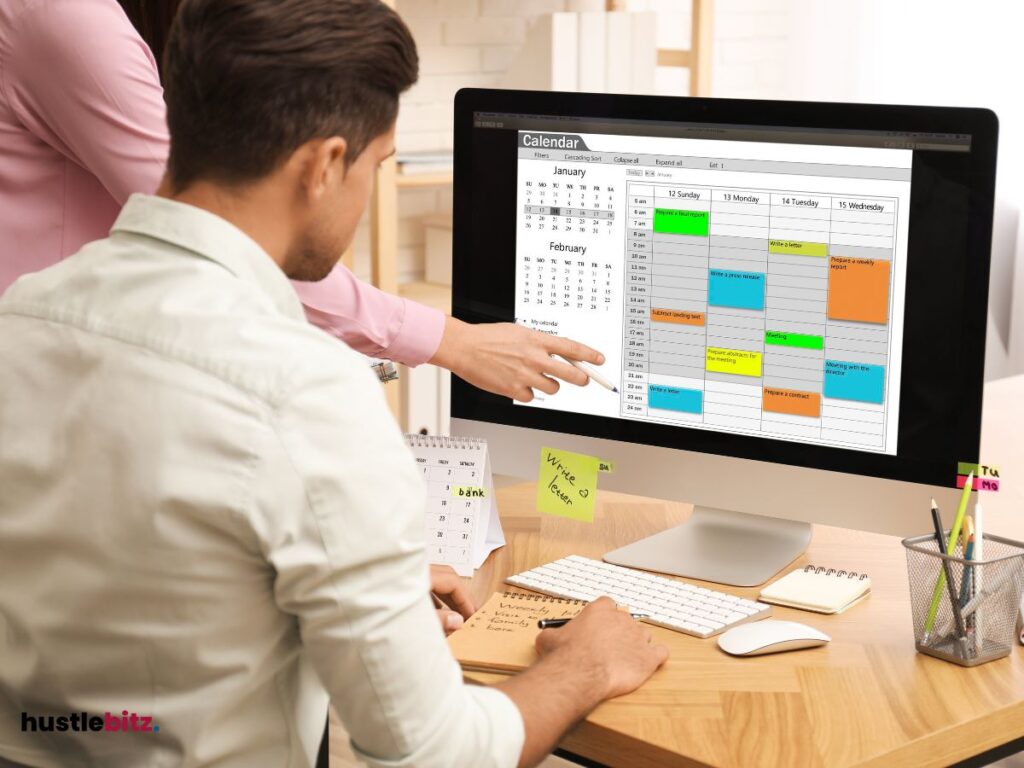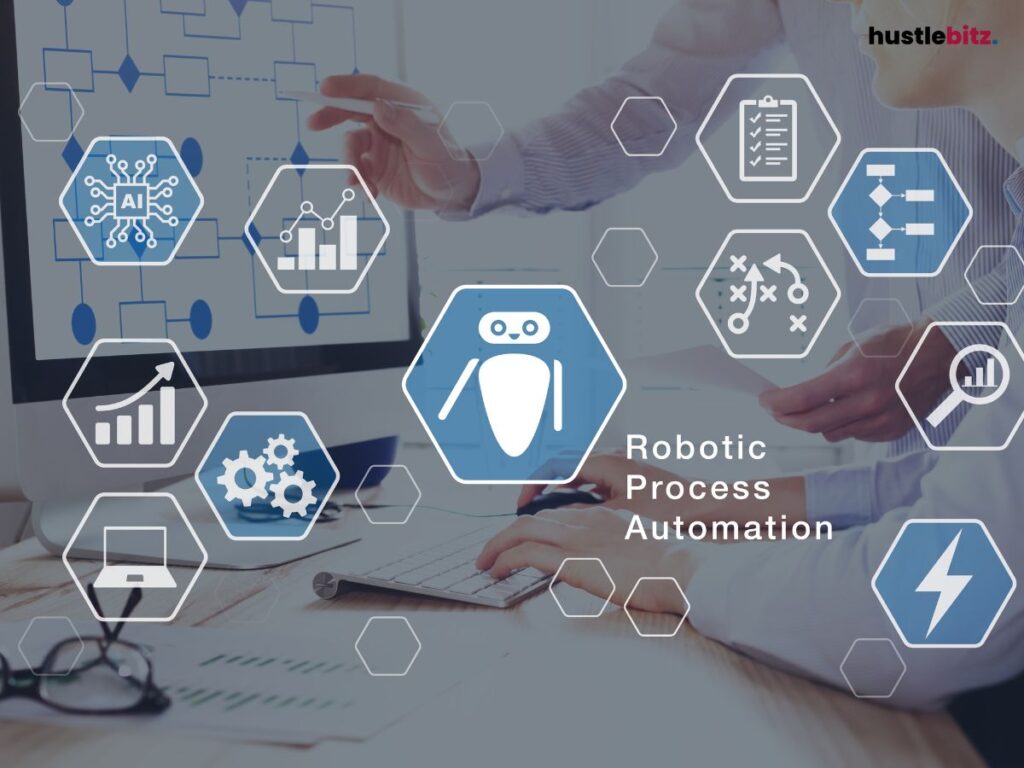To boost your productivity, start by prioritizing tasks using tools like the Eisenhower Matrix. Implement the Pomodoro Technique for focused work intervals, supplemented by regular breaks to maintain mental clarity. Limit distractions by creating an organized workspace and setting digital boundaries. Clearly define your goals using the SMART criteria, and break larger projects into manageable mini-tasks. Automate repetitive tasks with technology, and utilize productivity apps for better time management. Establish accountability with partners to reinforce good habits. These strategies are just the beginning; there are many more effective techniques to explore.
Key Takeaways
- Utilize the Pomodoro Technique to maintain focus with 25-minute work intervals followed by short breaks, enhancing productivity and reducing burnout.
- Implement the Eisenhower Matrix to distinguish between urgent and important tasks, enabling effective prioritization and time management.
- Organize your workspace by decluttering and personalizing it to create an inviting environment that fosters concentration and efficiency.
- Leverage productivity apps and digital calendars to streamline task management, set reminders, and monitor your progress effectively.
- Break larger projects into mini-tasks to make them manageable, fostering a sense of achievement and maintaining motivation.

1. Prioritize Your Tasks

Prioritizing your tasks is essential for maximizing productivity and ensuring that you focus on what truly matters. A systematic approach to prioritization can significantly enhance your decision-making processes. One effective method is to distinguish between urgency vs importance, which allows you to allocate your time and resources more efficiently. By employing prioritization frameworks, you can categorize tasks based on their impact and alignment with your goals.
Implementing daily task reviews is a valuable practice that enables you to assess your workload and make necessary adjustments. Workload assessment methods can help you gauge the demands of each task, ensuring that you remain focused on high-impact activities. Utilizing task categorization methods, such as the Eisenhower Matrix, can further clarify which tasks should take precedence based on their urgency and significance.
Incorporating goal alignment techniques ensures that your daily tasks contribute to your long-term objectives. This alignment fosters a sense of purpose and motivation, which can enhance your emotional impact assessment, helping you recognize the value of each task. Additionally, leveraging time management tools can aid in tracking your progress and maintaining focus throughout the day.
Lastly, effective task delegation strategies can lighten your workload, allowing you to concentrate on tasks that require your unique skills. By mastering these techniques, you can cultivate a productive environment that not only enhances your efficiency but also supports your overall well-being.
Prioritizing your tasks is not merely a practice; it is a crucial skill that shapes your success in both personal and professional endeavors.
2. Use the Pomodoro Technique

The Pomodoro Technique, which involves breaking work into focused intervals followed by short breaks, can significantly enhance concentration and productivity. This method, developed by Francesco Cirillo, optimizes time management by encouraging you to work in 25-minute segments known as ‘Pomodoros,’ followed by a 5-minute break. This structured approach fosters productivity rhythms that help maintain mental clarity and reduce fatigue.
One of the primary Pomodoro benefits is its effectiveness in implementing focus techniques. By concentrating on a single task during each work interval, you can achieve deeper engagement and better quality output. This method also promotes task batching—grouping similar activities together—which increases efficiency and minimizes the mental load associated with switching tasks.
Additionally, the Pomodoro Technique supports stress reduction through its built-in breaks. These pauses allow time for reflection and rejuvenation, which can elevate your overall performance and facilitate goal setting. As you progress through each Pomodoro, you gain a sense of accomplishment, further motivating you to stay on track.
Moreover, the technique aids in distraction control, as you commit to focusing solely on the task at hand during the Pomodoro. This not only enhances your ability to meet deadlines but also fosters a more satisfying work experience. By implementing the Pomodoro Technique, you can transform how you approach tasks, ultimately leading to improved productivity and a greater sense of well-being in your professional life.
3. Limit Distractions

Limiting distractions is essential for maintaining focus and enhancing productivity in any work environment. One effective strategy is to engage in a digital detox, reducing time spent on devices that often fragment attention. By setting social media limits, individuals can prevent the constant notifications from derailing their concentration.
Creating focused environments is another vital component. Environment design plays a significant role in minimizing distractions; a clutter-free workspace encourages clearer thinking. Implementing noise management techniques, such as using white noise machines or noise-canceling headphones, can further shield against auditory interruptions.
Mindfulness practices, including meditation and deep breathing exercises, contribute to improved focus. These techniques cultivate awareness of one’s thoughts, making it easier to redirect attention back to the task at hand. Additionally, time blocking can help structure the day into dedicated segments for focused work, allowing for deeper engagement with each task.
In pursuit of single-tasking benefits, it’s crucial to resist the temptation to multitask, which can diminish overall productivity. Partnering with accountability partners can also enhance focus; sharing goals and progress fosters a sense of responsibility and motivation.
Ultimately, by consciously limiting distractions, individuals can create an environment conducive to deep work and sustained concentration, leading to increased productivity and fulfillment in their professional endeavors.
4. Set Clear Goals

Establishing clear goals is fundamental for guiding efforts and measuring progress in any productive endeavor. Effective goal setting transforms vague aspirations into concrete objectives, enabling individuals to focus their energies and resources efficiently. A widely recognized method for achieving clarity in goal setting is the SMART framework, which encourages the formulation of Specific, Measurable, Achievable, Relevant, and Time-bound objectives.
To maintain motivation and remind oneself of these goals, visual reminders, such as vision boards or charts, can serve as powerful tools. Additionally, sharing your goals with accountability partners can significantly enhance commitment and provide support, ensuring that you stay on track. Aligning daily actions with a long-term vision fosters a sense of purpose, while daily affirmations can reinforce a positive mindset.
Progress tracking is essential for evaluating how effectively you are moving towards your goals. Regularly assessing success metrics not only provides insight into your achievements but also highlights areas requiring adjustment. Integrating motivational quotes into your routine can further inspire perseverance and enthusiasm in the face of challenges.
Ultimately, setting clear goals that resonate with your personal vision is imperative for attaining success. By implementing these strategies, you will cultivate a structured approach to productivity that empowers you to realize your objectives and thrive in both personal and professional domains.
5. Automate Repetitive Tasks

Automating repetitive tasks can significantly enhance productivity by freeing up valuable time and mental energy for more complex and strategic activities. By leveraging technology, professionals can streamline their processes, allowing them to focus on tasks that require critical thinking and creativity.
Task scheduling tools can help organize and prioritize daily activities, ensuring that deadlines are met without the need for constant manual oversight. Workflow optimization through automation can dramatically improve efficiency; for example, integrating email filtering systems can minimize distractions by directing important communications to designated folders.
For data-heavy tasks such as data entry and report generation, automation tools can reduce human error and accelerate completion times. Similarly, social media management platforms can automate post scheduling and engagement tracking, allowing marketers to maintain their online presence without dedicating excessive time.
Using project templates can expedite the initiation of new projects, ensuring consistency while saving time on repetitive setup tasks. Invoice processing can also be streamlined through automation, allowing businesses to manage finances more effectively and with fewer resources.
Additionally, reminder tools can assist in keeping track of important tasks and deadlines, while task delegation features within project management software can ensure that responsibilities are distributed efficiently among team members.
6. Take Regular Breaks
Taking regular breaks is essential for maintaining productivity and ensuring sustained mental clarity throughout the workday. Engaging in mindful moments allows individuals to step away from their tasks, promoting energy renewal and focus restoration. These short intervals serve as an opportunity for physical movement, which counteracts the sedentary nature of many jobs and contributes to overall health.
Research indicates that taking breaks can significantly enhance well-being by reducing stress levels. When individuals return to their work after a brief respite, they often experience a creativity boost, enabling them to approach problems with fresh perspectives. This cyclical process of work and rest fosters improved productivity, as it prevents burnout and fatigue that can arise from prolonged periods of concentration.
Incorporating structured breaks into your work routine not only supports mental clarity but also encourages a healthy work-life balance. By allocating time for relaxation, individuals can recharge their cognitive resources, ultimately leading to more effective and efficient work sessions.
7. Organize Your Workspace

A well-organized workspace enhances focus and productivity, complementing the benefits gained from taking regular breaks.
Adopting effective workspace decluttering strategies can significantly reduce distractions, allowing you to immerse yourself in your tasks. Start by implementing the following three essential steps to transform your work environment:
- Minimize Visual Clutter: Remove unnecessary items and keep only essential office supplies within reach. This not only creates a more inviting space but also helps in maintaining a cleanliness routine that supports mental clarity.
- Optimize Your Ergonomic Desk Setup: Arrange your desk to promote comfort and efficiency. Ensure your chair offers proper support, and position your computer screen at eye level. An ergonomic setup is crucial for reducing fatigue and enhancing productivity ambiance.
- Organize Digital Files: A cluttered digital workspace can be just as distracting as a chaotic physical one. Regularly sort through your files, categorize them, and establish a reliable naming system to streamline access.
Personalizing your work environment with effective shelving solutions can further enhance focus.
Incorporate elements that inspire you while maintaining organization.
Additionally, optimizing lighting conditions can create a more productive atmosphere.
8. Leverage Technology Tools

Harnessing the power of technology tools can significantly enhance productivity by streamlining tasks and improving time management. In today’s fast-paced environment, utilizing productivity apps can help you stay organized and focused on your priorities. Digital calendars, for instance, allow you to schedule appointments and set reminders, ensuring that you never miss an important deadline.
Effective task management is crucial for maintaining a productive workflow. Tools like task management software enable you to prioritize tasks, create to-do lists, and monitor your progress. By integrating collaboration tools, team members can communicate in real-time, share updates, and work together on projects more efficiently.
Cloud storage solutions provide a secure and accessible way to store documents, making it easy to retrieve files from any device. This flexibility supports remote work and enhances collaboration among team members, regardless of their location. Additionally, project tracking software helps you maintain oversight of ongoing tasks, ensuring that projects stay on schedule and within budget.
To maintain focus, consider using focus timers, which break work into manageable intervals, maximizing concentration while preventing burnout. Note-taking software allows you to capture ideas and information quickly, facilitating better retention and retrieval when needed.
9. Create Barriers for Bad Habits
Creating barriers for bad habits is an effective strategy to enhance overall productivity, as it minimizes distractions and helps maintain focus on important tasks. By understanding habit triggers and employing environmental design, individuals can create an atmosphere conducive to positive behaviors while discouraging detrimental ones.
Here are three impactful ways to establish barriers:
- Digital Detox: Limit your use of distracting apps and notifications. Designate specific times for checking emails or social media, allowing for uninterrupted work periods, especially when utilizing time blocking techniques.
- Accountability Partners: Involve someone you trust to help monitor your progress. Sharing goals with an accountability partner can reinforce commitment and provide motivation, making it harder to slip back into bad habits.
- Visual Reminders: Use visual cues to prompt mindfulness practices and reinforce good habits. For instance, placing a reminder note on your desk can help you refocus when distractions arise.
Incorporating reward systems and habit stacking can also enhance the effectiveness of these barriers. For example, rewarding yourself after completing a challenging task reinforces positive behavior.
Additionally, employing self-reflection tools allows you to assess your progress and adjust strategies as needed.
10. Break Projects Down Into Mini-Tasks

Breaking projects down into mini-tasks enhances focus and makes daunting assignments more manageable, ultimately leading to increased productivity and a clearer path to completion. By implementing effective task delegation strategies, you can distribute responsibilities among team members, allowing for a more collaborative approach. This not only relieves individual pressure but also fosters a sense of ownership and accountability.
The mini-task benefits are numerous. First, they provide motivation techniques that keep you engaged. Completing small tasks creates incremental achievements, which serve as a continual source of encouragement. Moreover, these mini-tasks allow for precise tracking of progress, making it easier to identify areas needing adjustment or additional resources.
Incorporating time management practices is essential when breaking down projects. Schedule specific time slots for each mini-task to enhance focus techniques and maintain momentum. Utilizing goal visualization can also be beneficial, as it keeps the end objective in sight, enabling you to prioritize effectively.
To further enhance productivity, consider enlisting accountability partners. Sharing your mini-task list with someone else can create external motivation, reducing the likelihood of procrastination. When you know someone is aware of your commitments, you are more likely to follow through.
Final Thoughts
Maximizing productivity involves a combination of effective strategies and tools designed to streamline your work process and maintain focus. By prioritizing tasks, utilizing techniques like the Pomodoro Method, and creating a distraction-free environment, you set yourself up for success. Setting clear goals and automating repetitive tasks further enhances your efficiency, while regular breaks and an organized workspace help sustain your energy levels. Leveraging technology tools and establishing barriers for bad habits can also contribute to better productivity and improved performance. Remember, the key to productivity is not just about working harder but working smarter. Implement these hacks to boost your effectiveness and achieve your goals more efficiently.




